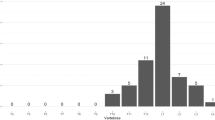Abstract
The vertebral fracture status of women with osteoporosis has strong prognostic implications that may influence clinical decisions. We developed a simple method for estimating the probability that a new vertebral fracture has occurred in postmenopausal women with osteoporosis. Data was from the placebo groups of the Fracture Prevention Trial (median observation =21 months) and the MORE Trial at 2 years. A logistic regression analysis identified prior vertebral fracture (yes/no), new or worsening back pain (yes/no), and height loss (≥2 cm, yes/no) as significant predictors for the presence of a new vertebral fracture. The actual probability of a new vertebral fracture in patients without these predictors, over the median observation period of 23 months, was 2.1%. Presence of back pain increased this probability fourfold; prior vertebral fracture increased this probability threefold, and height loss ≥2 cm increased this probability threefold. The predicted probabilities of a new vertebral fracture being present for each subgroup representing each of the eight possible combinations of back pain, prior vertebral fracture, and height loss were highly correlated with both the multivariate logistic regression-derived probabilities (r=0.98, p <0.001) and with the actual probabilities (r=0.99, p <0.001). The validity of this simple method was confirmed in patients from the MORE trial at both 2 years and 3 years, and in the Fracture Prevention Trial alone. This simple method provides clinicians with an estimate of the probability that a new vertebral fracture has occurred in postmenopausal women with osteoporosis.
Similar content being viewed by others
References
Nevitt MC, Ettinger B, Black DM, Stone K, Jamal SA, Ensrud K et al (1998) The association of radiographically detected vertebral fractures with back pain and function: a prospective study. Ann Intern Med 128(10):793–800
Kado DM, Browner WS, Palermo L, Nevitt MC, Genant HK, Cummings SR (1999) Vertebral fractures and mortality in older women: a prospective study. Study of Osteoporotic Fractures Research Group. Arch Intern Med 159(11):1215–1220
Huang C, Ross PD, Wasnich RD (1996) Vertebral fracture and other predictors of physical impairment and health care utilization. Arch Intern Med 156(21):2469–2475
Ross PD, Davis JW, Epstein RS, Wasnich RD (1991) Pre-existing fractures and bone mass predict vertebral fracture incidence in women. Ann Intern Med 114(11):919–923
Lindsay R, Silverman SL, Cooper C, Hanley DA, Barton I, Broy SB et al (2001) Risk of new vertebral fracture in the year following a fracture. JAMA 285(3):320–323
Black DM, Arden NK, Palermo L, Pearson J, Cummings SR (1999) Prevalent vertebral deformities predict hip fractures and new vertebral deformities but not wrist fractures. Study of Osteoporotic Fractures Research Group. J Bone Miner Res 14(5):821–828
Klotzbuecher CM, Ross PD, Landsman PB, Abbott TA 3rd, Berger M (2000) Patients with prior fractures have an increased risk of future fractures: a summary of the literature and statistical synthesis. J Bone Miner Res 15(4):721–739
Lauritzen JB, Lund B (1993) Risk of hip fracture after osteoporosis fractures. 451 women with fracture of lumbar spine, olecranon, knee or ankle. Acta Orthop Scand 64(3):297–300
Melton LJ 3rd, Atkinson EJ, Cooper C, O’Fallon WM, Riggs BL (1999) Vertebral fractures predict subsequent fractures. Osteoporos Int 10(3):214–221
Cooper C, Atkinson EJ, O’Fallon WM, Melton LJ 3rd (1992) Incidence of clinically diagnosed vertebral fractures: a population-based study in Rochester, Minnesota, 1985–1989. J Bone Miner Res 7(2):221–227
Nguyen TV, Sambrook PN, Eisman JA (1998) Bone loss, physical activity, and weight change in elderly women: the Dubbo Osteoporosis Epidemiology Study. J Bone Miner Res 13(9):1458–1467
Weatherall M (2004) Prevention of falls and fall-related fractures in community-dwelling older adults: a meta-analysis of estimates of effectiveness based on recent guidelines. Intern Med J 34(3):102–108
Marcus R, Wong M, Heath H 3rd, Stock JL (2002) Antiresorptive treatment of postmenopausal osteoporosis: comparison of study designs and outcomes in large clinical trials with fracture as an endpoint. Endocr Rev 23(1):16–37
Genant HK, Li J, Wu CY, Shepherd JA (2000) Vertebral fractures in osteoporosis: a new method for clinical assessment. J Clin Densitom 3(3):281–290
Neer RM, Arnaud CD, Zanchetta JR, Prince R, Gaich GA, Reginster JY et al (2001) Effect of parathyroid hormone (1–34) on fractures and bone mineral density in postmenopausal women with osteoporosis. N Engl J Med 344(19):1434–1441
Ettinger B, Black DM, Mitlak BH, Knickerbocker RK, Nickelsen T, Genant HK et al (1999) Reduction of vertebral fracture risk in postmenopausal women with osteoporosis treated with raloxifene: results from a 3-year randomized clinical trial. Multiple Outcomes of Raloxifene Evaluation (MORE) Investigators. JAMA 282(7):637–645
Grigoryan M, Guermazi A, Roemer FW, Delmas PD, Genant HK (2003) Recognizing and reporting osteoporotic vertebral fractures. Eur Spine J 12 [Suppl 2]:S104–112
Genant HK, Wu CY, van Kuijk C, Nevitt MC (1993) Vertebral fracture assessment using a semiquantitative technique. J Bone Miner Res 8(9):1137–1148
Lu Y, Ye K, Mathur AK, Hui S, Fuerst TP, Genant HK (1997) Comparative calibration without a gold standard. Stat Med 16(16):1889–1905
Siminoski K, Jiang G, Adachi JD, Hanley DA, Cline G, Ioannidis G et al (2004) Accuracy of height loss during prospective monitoring for detection of incident vertebral fractures. Osteoporos Int
Black DM, Steinbuch M, Palermo L, Dargent-Molina P, Lindsay R, Hoseyni MS et al (2001) An assessment tool for predicting fracture risk in postmenopausal women. Osteoporos Int 12(7):519–528
McGrother CW, Donaldson MM, Clayton D, Abrams KR, Clarke M (2002) Evaluation of a hip fracture risk score for assessing elderly women: the Melton Osteoporotic Fracture (MOF) study. Osteoporos Int 13(1):89–96
Burger H, de Laet CE, Weel AE, Hofman A, Pols HA (1999) Added value of bone mineral density in hip fracture risk scores. Bone 25(3):369–374
Acknowledgements
The authors thank the investigators of the Fracture Prevention and MORE Trials. Data were analyzed at Lilly Research Laboratories, Eli Lilly and Company. This study was supported by Eli Lilly and Company
Author information
Authors and Affiliations
Corresponding author
Rights and permissions
About this article
Cite this article
Krege, J.H., Siminoski, K., Adachi, J.D. et al. A simple method for determining the probability a new vertebral fracture is present in postmenopausal women with osteoporosis. Osteoporos Int 17, 379–386 (2006). https://doi.org/10.1007/s00198-005-2005-2
Received:
Accepted:
Published:
Issue Date:
DOI: https://doi.org/10.1007/s00198-005-2005-2




